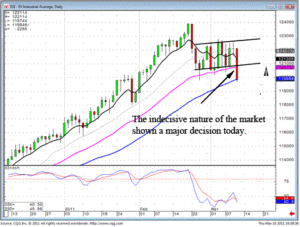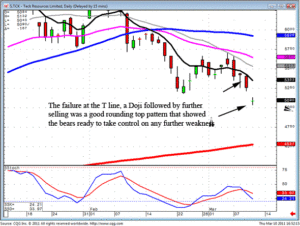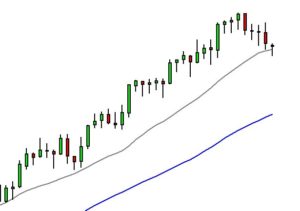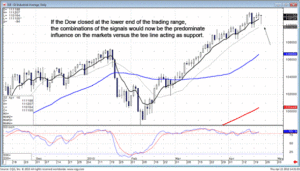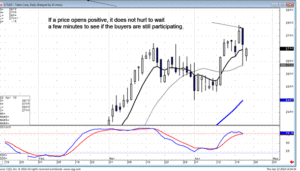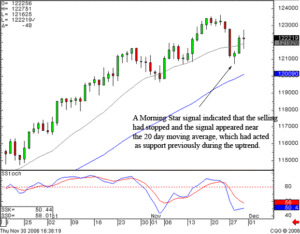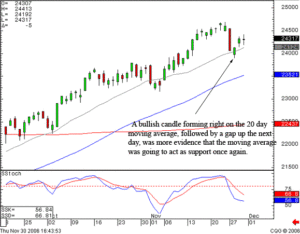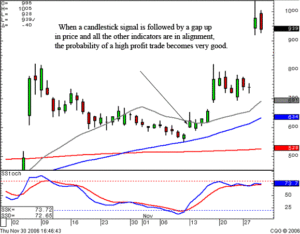Profitable stock trading over the long term does not come from luck. It does not come from stock tips. Profitable stock trading is the result of applying the best trading practices to stock trading. Profits come from using the best trading practices day in and day out for weeks, months, and years. Best trading practices include technical analysis of stocks with profitable trading tools like Candlestick analysis as well routine fundamental analysis to identify a stock’s margin of safety and intrinsic stock value. Best trading practices may vary from stock trader to stock trader, depending upon whether the trader is seeking profits in options trading, scalping profits from movements in stock price, or employing other trading strategies. No matter what strategy and tactics traders choose to employ, best trading practices will include the routine review of trading results in order to identify what works and what does not. Profit comes from a sound trading strategy and greater profit comes from a continuously improved trading strategy.
Because stock price patterns repeat themselves the alert trader using technical analysis tools like Candlestick pattern formations can profitably anticipate changes in stock prices. The underlying reasons for why stock price patterns develop vary according to market conditions. Part of a pattern will be due to stock fundamentals and part will be due to market reaction. The technical trader will always be wise to be aware of the fundamentals driving a stock price. However, his best trading practices will typically revolve around trading according to technical analysis of Candlestick patterns. These easy to recognize stock trading signals have been around for centuries, having evolved in commodities trading of rice in ancient Japan. These representations of stock price patterns are excellent predictors of market trends as well as market reversal.
They are equally useful in trading futures, commodities, stocks, options, and Forex.
Although there are best trading practices applicable to direct stock trading, options trading, or futures trading there are also best trading practices principles that apply to changing tactics as market conditions vary. For example, a trader may find profits in scalping in a market that is in an upswing but has a fair amount of stock volatility. However, if the volatility becomes extreme the trader may switch to options trading in order to reduce investment risk while still using Candlestick chart analysis to predict price movement and gain profits. Using strategies such as a long straddle the trader can buy both a call and a put on the same stock with the same options expiration date. In such a way he will profit if the stock goes up or down and will limit his risk to the price of there premiums paid.
A trader’s best trading practices will be those that work the best for him. Taking time to learn about individual stocks or about new stock trading tactics is a basic necessity for successful trading. Learning how to trade individual stocks while still maintaining a broader view of the stock market is one of the best trading practices as it will continually help the trader find the next profitable trading opportunity even as he is executing trades on the current one. Because none of us is perfect we all make mistakes. It is through the review of trading results that traders learn and continually improve trading profits.
Understanding the underlying forces that are involved with the creation of candlestick reversal signals becomes an extremely important factor for analyzing a market trend. The signals demonstrate the bias of investor sentiment. Utilizing this information allows for a much more comfortable trading process for the candlestick investor. There will always be times when prices appear to be going against what the predominant signal has revealed. Stepping back and analyzing which signal is still the predominant signal will allow an investor to make entry and exit decisions more accurately. A price trend is not always going to go in one direction without some waffling. Understanding which signal is still the predominant signal keeps an investor from exiting a trade too early.
The April Live Cattle chart demonstrates how respecting the latest candlestick signal can keep an investor from exiting a trade too early. The Evening Star/Bearish Engulfing signal, that closed below the T-line, was considered the predominant signal. Monday’s trading would have been very uncomfortable for the short positions that had shorted based upon the candlestick sell signal. As can be seen, the following three days after the big sell signal, investor sentiment was indecisive. However, there was nothing that indicated the sell signal was still not the predominant analytical factor. Today’s trading saw bullish trading early in the day. Unless today’s trading finished very strong, nothing yet had changed the message conveyed from the large sell signal. The Evening Star signal would have been negated had today’s trading closed more than halfway up the large bearish candle.
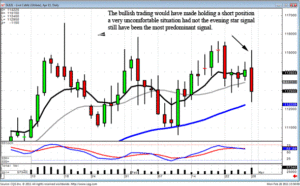
Live Cattle April
Before the end of the day, the buying disappeared and the sellers came back. This obviously continued the downtrend. Suspecting the downtrend was not over at least allowed an investor to decide that if they covered their short positions, they should be prepared to reestablish the position if the selling became evident again. There are a number of simple common sense nuances associated with candlestick analysis that can greatly improve how an investor interprets a price trend.
The Dow made a strong showing today, closing above the T-line. Visually analyze the Dow as a possible J-hook type pattern. This provides evidence the uptrend may still be in progress for a few more weeks. The NASDAQ is showing the same strength, but on different days. The combination of the two indexes provide a good indication to be relatively bullish in the portfolio. Where many analysts are advising to be cautious, thus limiting the potential gains of a bullish trend, candlestick analysis more clearly reveals the direction of the market. This allows for establishing positions in the portfolio with more confidence.
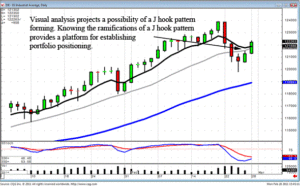
DOW
There are many aspects to candlestick analysis that diminish the emotions involved with trading. Once an individual understands the benefits of candlestick signals information, they can trade with more confidence and react less to outside factors that play more upon investors emotions than they do the reality of price moves.
Chat session tonight at 8 PM ET.
Good Investing,
The Candlestick Forum Team
Candlestick Profits – Eliminating Emotions With Candlestick Analysis


